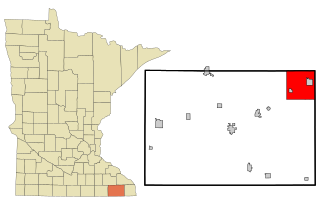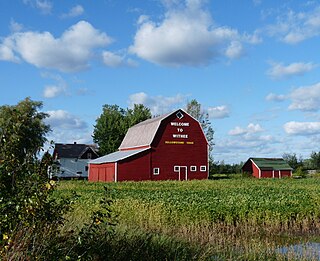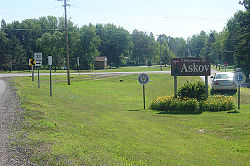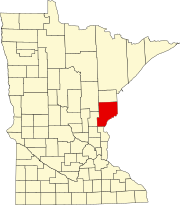
Pine County is a county in the U.S. state of Minnesota. As of the 2020 census, the population was 28,876. Its county seat is Pine City. The county was formed in 1856 and organized in 1872. Today, Pine County is the fastest growing county in the state.

Partridge is a city in Reno County, Kansas, United States. As of the 2020 census, the population of the city was 209.

Ramsey is a suburban city 22 miles (35 km) north-northwest of downtown Minneapolis in Anoka County, Minnesota, United States. The population was 27,646 at the 2020 census. It is a northwest suburb of the Twin Cities.

Trommald is a city in Crow Wing County, Minnesota, United States. The population was 99 at the 2020 census. It is part of the Brainerd Micropolitan Statistical Area.

Rushford Village is a city in Fillmore County, Minnesota, United States. The population was 807 at the 2010 census. It surrounds the city of Rushford.

Clarks Grove is a city in Freeborn County, Minnesota, United States. The population was 706 at the 2010 census.

Tyler is a city in Lincoln County, Minnesota, United States. The population of Tyler was 1,143 at the 2010 census.

Bremen Township is a township in Pine County, Minnesota, United States. The population was 246 at the 2000 census.

Brook Park is a city in Pine County, Minnesota, United States. The population was 139 at the 2010 census.

Finlayson is a city in Pine County, Minnesota, United States. The population was 315 at the 2010 census. The city's area was incorporated from Finlayson Township, the remainder of which is still adjacent to it. https://finlayson.municipalimpact.com/
Finlayson Township is a township in Pine County, Minnesota, United States. The population was 506 at the 2000 census. The township's original extent was reduced when the city of Finlayson was incorporated and separated from it.

Hinckley is a city in Pine County, Minnesota, United States, located at the junction of Interstate 35 and Minnesota State Highway 48. The population was 1,800 at the 2010 census.

Kerrick is a city in Pine County, Minnesota, United States. The population was 65 at the 2010 census.
Partridge Township is a township in Pine County, Minnesota, United States. The population was 518 at the 2000 census.

Brookston is a city in Saint Louis County, Minnesota, United States; located along the Saint Louis River, opposite the mouth of the Artichoke River. The population was 118 at the 2020 census.

Belgrade is a city in Stearns County, Minnesota, United States. The population was 740 at the 2010 census. It is part of the St. Cloud Metropolitan Statistical Area. Belgrade is home to the world's largest black Crow.

Aldrich is a city in Wadena County, Minnesota, United States, along the Partridge River. The population was 48 at the 2010 census. The small community holds the distinction as the first permanent settlement in Wadena County and the first to establish a post office. It is also home to the first Catholic church in the area, established in 1870, as a mission church.

Bena is a city in Cass County, Minnesota, United States. The population was 116 at the 2010 census. It is part of the Brainerd Micropolitan Statistical Area.

Battle Lake is a city in Otter Tail County, Minnesota, United States. The population was 857 according to the 2020 census.

Withee is a village in Clark County in the U.S. state of Wisconsin. The population was 487 at the 2010 census. The village is located mostly within the Town of Hixon, with a small portion extending south into the Town of Longwood.




















